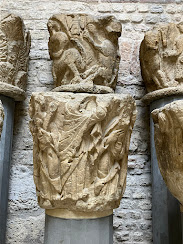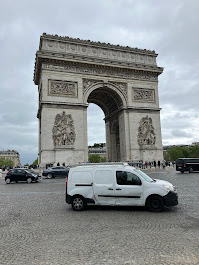This afternoon Chris and I were out and about and he showed me something on his phone about the phrase "We'll always have Paris," from the classic movie "Casablanca." His comment: I promise I'll never say this to you. I said to him, "Well, I actually used this phrase as the title of my blog."
That being said, Chris said to me yesterday morning that this 5 month trip has been like a second honeymoon. We have always been pretty independent - together in the morning, but then going our separate ways and coming back together in the evening. Here we have pretty much been joined at the hip, discovering and sharing a place we love. And we are going home to people we love and a city we expect to learn to love - and already really like it a lot!
So we are saying good-bye to Paris. I'm sure we will return. We've been making good use of our last week here. We've done some wandering and we've been to two noteworthy museums: The Musée Marmottan Monet and the Musée Cluny (shout out to Mimi for suggesting this museum!).
The Musée Marmottan Monet resides in a house in Paris that was a hunting lodge of the Marmottan family.
The first floor has retained the look of the hunting lodge.
The son of the family, Paul, expanded his father's collection of art and bequeathed the house at his death to the Académie des Beaux Arts. The academy then received additional donations from Michel Monet, Claude Monet's son, as well as others, including the daughter of Berthe Morisot, the sole woman to be invited to join the Impressionist movement. The most famous painting in the collection is Monet's Soliel Levant (The Rising Sun), which I seem to recall seeing in the Musée d'Orsay. I guess there is more than one. In any case, it was not on display because it is loaned out to The National Gallery of Art in Washington, D.C. at this time. I was particularly interested in Berthe Morisot's paintings, but I saw these two works by Monet that I really liked.
The light in these paintings is really amazing.
On to Berthe Morisot. First, let's start with a picture of the artist.
What I like about Morisot is the composition of her paintings. The first one we saw was this one.
Chris and I both agreed that this painting just seemed more interesting in terms of content than many paintings. There is so much going on here: the boats, the water, the women, the curtains, the man looking out, the way the curtains frame the picture.
And of course, women paint women and girls. I especially liked this one of two girls picking cherries, especially the use of the variations of green.
It's clear that Morisot certainly deserved to be included in the Impressionist movement. Which pretty much exhausts my erudition on art. I'm kind of an "I know what I like" person.
We've been getting some great recommendations from people about where to spend our last few days in Paris. My friend Mimi suggested the Musée Cluny, especially the Roman baths. The 13th century building housed a monastic order and was one of three sites for novices of the order to study. The abbot of the order stayed in the Cluny castle in Paris when he visited.
We visited the main collection of the museum first. The photos below are of original items from area churches. These items were too damaged to retain, but offered valuable history: tops of columns, door jambs, and sculptures of saints and kings - most from the 11th to 12 centuries. We've visited all the churches from which these items came.
Tops of columns from Eglise (Church) Saint Germain des Prés
A door jamb from Eglise Saint Denis
Sculptured heads from Cathédrale Notre Dame de Paris
Original stained glass from Eglise Saint Denis
The other notable exhibit was the tapestries of "The Lady and the Unicorn." These are a series of tapestries representing the 5 senses - although I have not been able to discern which tapestry represents which sense. I won't post all the photos here. You can check out
this link to learn more.
Now on to the baths. I just heard from my sister-in-law that when she was at Musée Cluny 10 years ago a dig was underway. That dig was undoubtedly of the 1st century Roman baths in the ground floor of the museum. The pictures shown are three levels: the ground floor where the hot and cold public paths were; the floor beneath where utility rooms were; and the lowest floor of the hydraulic network of sewers and pillars.
One of the public baths is beyond the black railing
The level under the baths
A corridor deep underneath
The only way to see the lower levels is by tour and I really wanted to see these levels. The tour on Wednesday was only in French. I tried my best to listen and interpret for Chris, but honestly, most of the information I have here is from the website!
Yesterday Chris worked, so I set out to see something I'd wanted to see before we leave: The oldest house in Paris. It happened to belong to Nicholas Flamel. Remember Nicholas Flamel from the Harry Potter books? He was a real person. He was a scientist and mathematician who was believed to be an alchemist. But he was also a man with a heart for the poor, and the house became a refuge for the poor who were welcome to stay there as long as they recited the Our Father and the Hail Mary every morning and evening. It is now a restaurant, but still considered an off-the-beaten-path tourist site.
This is my last blog from Paris. I hope to post one more from Chicago, but we are going to hit the ground running when we get back.
It's been a joyous journey and I am honored that you have traveled it with me via this blog.




















Comments
Post a Comment